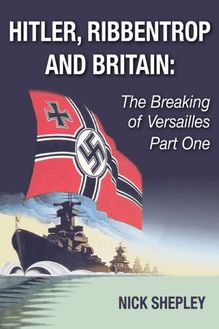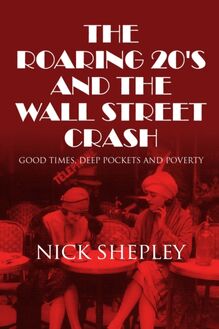-
 Univers
Univers
-
 Ebooks
Ebooks
-
 Livres audio
Livres audio
-
 Presse
Presse
-
 Podcasts
Podcasts
-
 BD
BD
-
 Documents
Documents
-
- Cours
- Révisions
- Ressources pédagogiques
- Sciences de l’éducation
- Manuels scolaires
- Langues
- Travaux de classe
- Annales de BEP
- Etudes supérieures
- Maternelle et primaire
- Fiches de lecture
- Orientation scolaire
- Méthodologie
- Corrigés de devoir
- Annales d’examens et concours
- Annales du bac
- Annales du brevet
- Rapports de stage
La lecture à portée de main
Vous pourrez modifier la taille du texte de cet ouvrage
Découvre YouScribe en t'inscrivant gratuitement
Je m'inscrisDécouvre YouScribe en t'inscrivant gratuitement
Je m'inscrisEn savoir plus
Vous pourrez modifier la taille du texte de cet ouvrage
En savoir plus

Description
Informations
| Publié par | Andrews UK |
| Date de parution | 07 décembre 2015 |
| Nombre de lectures | 0 |
| EAN13 | 9781783330874 |
| Langue | English |
Informations légales : prix de location à la page 0,0150€. Cette information est donnée uniquement à titre indicatif conformément à la législation en vigueur.
Extrait
Title Page
STALIN, THE FIVE YEAR PLANS AND THE GULAGS: SLAVERY AND TERROR 1929-53
20th Century Russia Part Two
by
Nick Shepley
Publisher Information
Published in 2013 by
Andrews UK Limited
www.andrewsuk.com
The right of Nick Shepley to be identified as the Author of this Work has been asserted by him in accordance with the Copyright, Designs and Patents Act 1998
Copyright © 2013 Nick Shepley
All rights reserved. No part of this publication may be reproduced, stored in a retrieval system, or transmitted, in any form or by any means without the prior written permission of the publisher, nor be otherwise circulated in any form of binding or cover other than that in which it is published and without a similar condition being imposed on the subsequent purchaser. Any person who does so may be liable to criminal prosecution and civil claims for damages.
Introduction
Modernity, or modernisation, are terms with many connotations, but few fixed meanings. They are wonderful politicians words, they can mean all manner of things.
Russia’s real journey towards modernisation involves, paradoxically, such a staggering amount of barbarity and brutality, that one might reasonably conclude that there is often something barbaric about modernity itself. The wars of the 20th Century that have been fought in the name of modern enlightenment values, from Russia to Vietnam and most recently Iraq and Afghanistan have been savage tragedies, perpetrated in the name of modern orthodoxies, democracy, socialism, free markets and liberty, all barbaric in their own ways, all pursuing progress.
In Russia’s case this might not be an unreasonable conclusion, the break neck pace of industrialisation, featured in part one of this series: Russia’s Struggle With Modernity, began during the late 1920s, and was motivated in no small part by Stalin’s fear of the West. Stalin knew, as he made clear to the politburo and party, that Russia had a short amount of time, perhaps a decade, before the armies of counter revolution once again threatened her, as thy had during the Russian Civil War.
He also saw industrialisation as a way of shoring up the power base of the Soviet Communist Party in Russian society, which, by the early 1930s was still far from extending complete totalitarian control over all aspects of life. Stalin thought that industrialisation would be an historic opportunity for him to re-arrange all the various pieces on the chessboard of Russian society, to finally break the Russian peasantry, to promote the interests of the industrial working classes (the party’s natural constituency) and to make his own position within the party unassailable.
Stalin’s dramatic transformation of the Soviet Union from a largely peasant agrarian society to a military and industrial super power is breath taking in scale and pace, and was impossible to complete without enormous human cost. This ebook explores the forced collectivisation of Soviet agriculture and the resultant famine that many now regard as genocide. It examines the Five Year Plans that industrialised Russia, and their relationship to the vast chain of labour camps which provided that bulk of man power for Russia’s ‘modernisation’ and the terror that pervaded every aspect of the process.
Holodomor
The Bolsheviks had little time for the Russian peasantry, and certainly less time still for the rural poor of the Ukraine and other nationalities under their control. Their mistrust of the peasantry dated back to pre revolutionary 19 th Century Russia, when the revolutionary movement as a whole had witnessed peasant attitudes first hand.
The earlier, pre Bolshevik revolutionaries had harboured some naïve optimism about the peasants, looking to their village communes as a model for the organisation of society in the future. The uninformed outsider might well have learned that the land in the Russian Obschina or Mir was collectively owned and shared out equally between the families in the village, largely on the basis of need. They might well have observed that Russian peasants held a belief about land ownership that the only requirement for ownership of land was the ability to actually work it. If you could work your field, you were entitled to it, the idea that land should be owned to accumulate private profit was an anathema to the ordinary peasant. This was music to the ears of the Narodniks, the Russian student populists who went to ‘educate the peasants’ in the 1870s (for a full account of this, read volume one of this series), but they were soon to be disillusioned. Far from being a socialist paradise, they found squalor, alcoholism and violence rife in most peasant communities. The peasant was not the enlightened character they supposed he might be, but largely disinterested in politics, mostly illiterate, and highly suspicious of outsiders. An attempt to encourage revolution amongst the peasants failed, they handed the Narodniks over to the Czar’s secret police and returned to the day to day life of peasant Russia.
It could be argued that the Russian Intelligentsia and the rural classes were on a collision course ever since. Certainly, Lenin found himself under no illusions about the merits of the peasants. He doubted whether they could ever really be able to grasp the basic rudiments of socialist theory, and when Lenin and Trotsky failed to export revolution to Germany, and failed to gain access to German know how in order to modernise Russia, it meant that an altogether unexpected and more brutal approach to dragging the country into the 20 th Century would be required.
Lenin believed that the peasants of Russia were in the process of a shift towards capitalism during the late 19 th Century. He believed that after the emancipation of the serfs, which released Russian peasants from virtual slavery in 1861, that a two tier countryside was establishing itself.
On one had there were the new wealthy peasants, the ‘Kulaks’ (Kulak is the Russian word for fist, suggesting that the Kulaks were tight fisted), who in reality were for the most part far from wealthy, they had simply been more successful at farming than their neighbours, and probably less inclined to drink. On the other hand there were the less successful ‘poor peasantry’, identified by the Bolsheviks as potential supporters. Lenin fed off the envy and hatred of the vast sea of peasant poor, firstly directing its ire at the remaining land owner classes and the rural bourgeoisie. Lenin initially lacked the man power for a mass killing of his own in the countryside, and instead used propaganda and writing to enflame the hatred of the poor peasantry, a tactic that Stalin would later use against the Kulaks.
Using Bolshevik inspired ‘Committees of Poor Peasants’ or Kombeds, Lenin started a bloody class war in the countryside, at the same time as starving peasant communities with a state created famine from 1918-21.
The poor peasant, the Bednyak, was little more than a serf in the eyes of the regime, a pliant agricultural labourer and rural equivalent of the industrial proletariat. Middle class peasants, or Serednyaks owned land but rarely hired labour, they couldn’t afford to, they simply worked the land themselves. The Kulaks, who hired labour and owned land were the evidence that Lenin needed that capitalism seemed to spontaneously reassert itself in the countryside wherever peasants tended to congregate. He wrote:
“ Small-scale production gives birth to capitalism and the bourgeoisie constantly, daily, hourly, with elemental force, and in vast proportions.”
The Bednyaks were to make up the membership of the new peasant Kombeds, these committees would expropriate land in villages, find surpluses of grain and confiscate it, and would be allowed to practice in the Russian peasant village their own special brand of revolutionary vigilantism. Lenin claimed to be less interested in the affairs of the middle peasants, focusing generally on the Kulaks, he wrote:
“ Our task in the countryside is to destroy the landlord and smash the resistance of the exploiter and the kulak speculator. For this purpose we can rely firmly only on the semi-proletarians, the ‘poor peasants.’ But the middle peasant is not our enemy. He vacillated, is vacillating and will continue to vacillate. The task of influencing the vacillators is not identical with the task of overthrowing the exploiter and defeating the active enemy. The task at the present moment is to come to an agreement with the middle peasant, while never for a moment renouncing the fight against the kulak, and firmly relying solely on the poor peasant, for it is precisely now that a turn in our direction on the part of the middle peasantry if inevitable,* owing to the causes above enumerated. ” [1]
However, in many villages, the simple distinctions that the Bolsheviks placed upon wealth and poverty, the idea that there actually were wealthy peasants was considered an anathema. In many villages all peasants thought of themselves as poor, and no one recognised other members of their community as Kulaks. The peasants, much to the ire of Lenin, subverted the Kombedy by voting on to it a broad cross section of community life (nearly every peasant village was dominated by groupings of large inter related peasant families, all with loyalties and friendships that were difficult to dissolve).
Lenin tried to circumvent this problem by shipping into the peasant villages towns people who were disconnected from local politics. They dominated the Kombedy, in the face of resolute opposition from the peasants. In order to make their authority felt they had to back up their edicts with violent suppression.
Realising after the civil war that the Kombed had been a mistake, and realising also that the new model of
-
 Univers
Univers
-
 Ebooks
Ebooks
-
 Livres audio
Livres audio
-
 Presse
Presse
-
 Podcasts
Podcasts
-
 BD
BD
-
 Documents
Documents
-
Jeunesse
-
Littérature
-
Ressources professionnelles
-
Santé et bien-être
-
Savoirs
-
Education
-
Loisirs et hobbies
-
Art, musique et cinéma
-
Actualité et débat de société
-
Jeunesse
-
Littérature
-
Ressources professionnelles
-
Santé et bien-être
-
Savoirs
-
Education
-
Loisirs et hobbies
-
Art, musique et cinéma
-
Actualité et débat de société
-
Actualités
-
Lifestyle
-
Presse jeunesse
-
Presse professionnelle
-
Pratique
-
Presse sportive
-
Presse internationale
-
Culture & Médias
-
Action et Aventures
-
Science-fiction et Fantasy
-
Société
-
Jeunesse
-
Littérature
-
Ressources professionnelles
-
Santé et bien-être
-
Savoirs
-
Education
-
Loisirs et hobbies
-
Art, musique et cinéma
-
Actualité et débat de société
- Cours
- Révisions
- Ressources pédagogiques
- Sciences de l’éducation
- Manuels scolaires
- Langues
- Travaux de classe
- Annales de BEP
- Etudes supérieures
- Maternelle et primaire
- Fiches de lecture
- Orientation scolaire
- Méthodologie
- Corrigés de devoir
- Annales d’examens et concours
- Annales du bac
- Annales du brevet
- Rapports de stage




















